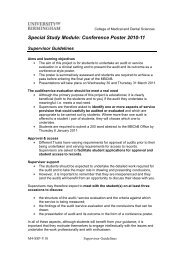Contents - College of Medical and Dental Sciences - University of ...
Contents - College of Medical and Dental Sciences - University of ...
Contents - College of Medical and Dental Sciences - University of ...
Create successful ePaper yourself
Turn your PDF publications into a flip-book with our unique Google optimized e-Paper software.
The 11 th International Workshop on KSHV & Related Agents, Birmingham, UK<br />
Poster Session Abstract P18<br />
KSHV KAPOSIN B SUPPRESSES THE HOST INTERFERON RESPONSE BY<br />
PREVENTING STAT1 PHOSPHORYLATION<br />
Christine A King, Jennifer A Corcoran <strong>and</strong> Craig McCormick<br />
Dalhousie <strong>University</strong>, Department <strong>of</strong> Microbiology <strong>and</strong> Immunology, Halifax, Nova Scotia,<br />
B3H 1X5, Canada.<br />
Abstract<br />
A central component <strong>of</strong> host antiviral defence is the interferon (IFN)-mediated antiviral<br />
pathway. Detection <strong>of</strong> virus by infected cells triggers the secretion <strong>of</strong> type I IFN (IFN-α or<br />
IFN-β) that engages specific receptors on target cells, resulting in activation <strong>of</strong> two<br />
receptor-associated tyrosine kinases, Jak1 <strong>and</strong> Tyk2. This is followed by tyrosine<br />
phosphorylation <strong>and</strong> heterodimerization <strong>of</strong> the STAT1 <strong>and</strong> STAT2 proteins.<br />
Phosphorylated STAT1 <strong>and</strong> STAT2 combine with IRF-9 to form the ISGF-3 complex,<br />
which, upon translocation to the nucleus, binds to the cis element ISRE (IFN-stimulated<br />
response element), to drive transcription <strong>of</strong> IFN responsive genes. To ensure viral<br />
persistence <strong>and</strong> productive infection, KSHV has evolved a variety <strong>of</strong> countermeasures to<br />
disrupt IFN signal transduction. Here we show that the latent KSHV kaposin B protein<br />
potently inhibits transcription from the interferon stimulated response element (ISRE) in<br />
response to IFN-α. Furthermore, primary human umbilical vein endothelial cells<br />
(HUVECs) expressing kaposin B fail to accumulate phosphorylated STAT1 in response to<br />
IFN-α <strong>and</strong> harbor decreased levels <strong>of</strong> total STAT1. Our data suggest that kaposin B<br />
interferes with the host IFN response thereby contributing to successful immune evasion<br />
by KSHV.<br />
Presenting author Email: caking@dal.ca<br />
115















